PBX Solutions: What is a PBX?
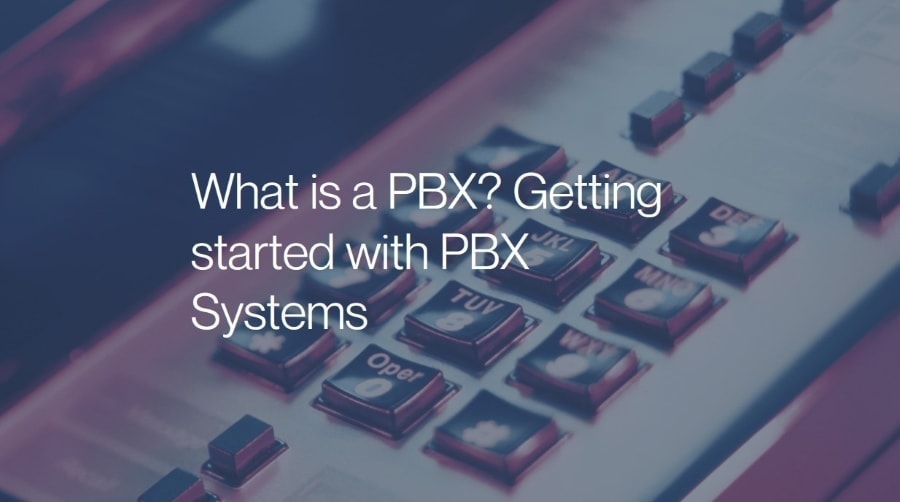
For businesses, practical and streamlined communications are essential. Inevitably, when looking for business telephone systems and their features, you will come across PBX solutions.
While these PBX phone system solutions will look impressive, it may not always be clear what is a PBX, how PBX solutions work, and how the PBX functions within the overall operation of the phone system.
Whether connecting with internal or external people, your business must invest in its telecommunications infrastructure. It is equally important to understand exactly what you are getting for your investment.
In the below article, we explain what PBX means and how PBX systems work. We also cover some of the technologies related to PBX telephony to help you get started with PBX solutions.
On this page:
What is a PBX?
Fundamentally, a PBX, or Private Branch Exchange, operates as the central switching system for phone calls within a business.
A PBX fulfils this role by making several outside lines, rented by a business, available for the staff to make outside phone calls. It does this by connecting the business phones with the shared external lines and connecting them to one another.
A PBX provides shared access to limited resources. By using a PBX solution, a business can connect a greater number of phones to lines required, thereby reducing costs, rather than having a separate phone line for each phone.
Traditionally, a PBX is made up of two components – namely, lines and stations. The lines commonly called trunks, and usually provided by a telephony company, connect to the public switched telephony network (PSTN). Stations refer to the telephones, handsets and other endpoint devices which require a phone line, such as a fax machines, or credit card terminal.
The Evolution of PBX Systems
Early PBX solutions, often consisting of switchboards, needed human operators. External calls would be connected to a department or a particular person by an operator.
Similarly, outbound calls would be connected to an available external line by the operator. Organizations which has a high call volume would employ dozens of operators to administer all the calls.
Through technology, these manual switchboards were replaced, first with electromagnetic, and then with electronic solutions.
This evolution saw ISDN PBX solutions replace traditional PBXs in the 1990s. ISDN offered advanced featured such as conference calling, call forwarding, and programmable caller ID, over previous technologies. However, now telecommunication carriers are expecting to phase out ISDN by 2025 in favour of IP-enabled networks.
In the digital era, the latest PBX solutions are based on IP technology, utilizing the internet to connect to the PSTN. Referred to as IP-PBX, these solutions are used in internet telephony, which uses IP desk phones or other IP-enabled endpoints.
How does a PBX work?
Before the digital age, analog PBX-based solutions used the landline copper-based phone lines, which entered into a business’s premises and connected to a PBX box. The PBX box would contain telephony switches that allowed calls to be directed to different phones within the office and those phones to access a limited number of external lines.
Modern PBX solutions, known as IP-PBX, make use of the internet, using digital phone signals, rather than analog landlines, to make and receive calls. Since digital PBX solutions use Ethernet cables to connect phones instead of traditional phone ones, no rewiring is needed.
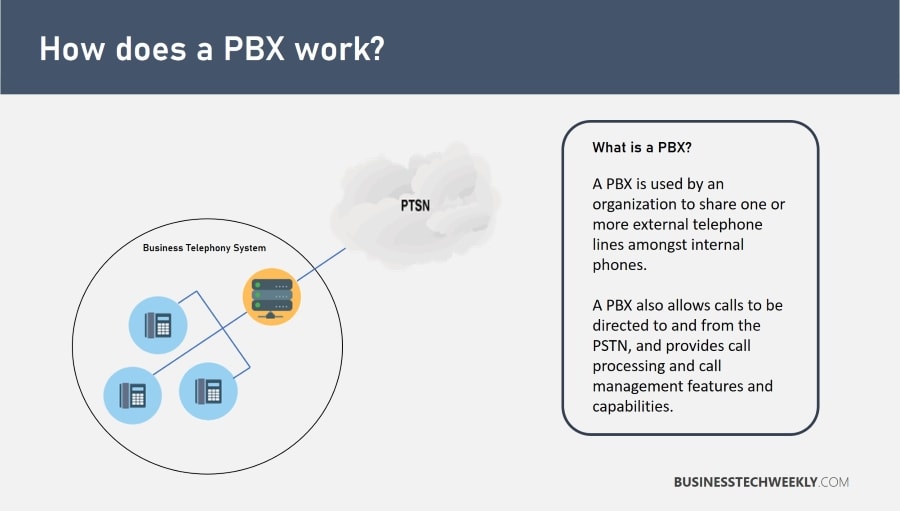
Main Functions of a Private Branch Exchange (PBX)
Regardless of the technology used, i.e. analog or digital, from a functional perspective, a PBX performs four primary call processing functions:
- Establishing a connection (known as a circuit) between two users’ telephony devices by mapping a dialed telephone number to a physical phone and making sure the phone isn’t already busy.
- Ensuring connections are maintained for as long as the users require them and transmitting and receiving voice signals between the users for this duration.
- Disconnecting the connection when required by the users.
- Capturing any information for accounting purposes (e.g. metering calls)
In addition to these call processing functions, a PBX offers features that enhance the handling of inbound calls. Common capabilities include auto-attendant/dialing, IVR (Interactive Voice Response), voicemail, and conferencing features.
Further capabilities include conferencing and call management features (such as call blocking, call forwarding on busy or absence, call pick-up or transfer, and call-waiting).
Modern IP-PBX solutions offer additional advanced features such as making and answering from desktops and integration to CRM (Customer Relationship Management) systems.
What are the benefits of using a PBX Phone System?
The primary advantage of using a PBX solution is the centralization of inbound and outbound call handling.
This centralized call handling and processing allows organizations to leverage external lines, or trunks, more effectively by employing fewer lines than the number of telephony devices rather than operating a dedicated telephone line for each phone.
In addition, to call processing, PBXs also offer a vast range of call management features, which provide numerous benefits for organizations.
Finally, PBX based phone solutions are also scalable, meaning that you can, in most cases, increase the number of phones, and if more capacity is required, the number of lines.
Consequently, PBXs offer a versatile and cost-effective telecommunications solution, allowing organizations to employ, at a minimum, a single line to handle several phone calls simultaneously.
Related: Benefits of VoIP Telephony
Key PBX Solution Components and Features
The equipment used in a PBX, and the features available in a PBX, will vary depending on the complexity of the solution.
For instance, a traditional analog PBX will have copper telephone landlines, whereas a hybrid PBX solution will accommodate analog and digital lines. IP-PBXs, on the other hand, use digital signals, utilizing voice over IP (VoIP) and can either be hosted on-site or a cloud-based PBX.
PBX System Components
In general, the components needed by a PBX phone solution include:
- PBX – to manage call processing and provide call management features
- Telephone trunk (multiple telephone) lines that terminate at the PBX and connect the PBX with the PSTN
- Power supply (PS)
- VoIP gateway and internet router – if you are using an older PBX, then this allows you to use your analog phone system with an IP based network
- Telephony application server – a management console to allow the administration of the telephony system (such as assigning and deleting extensions and devices)
- Endpoints such as desk phones, fax machines, credit card terminals, etc.
PBX Features
While still allowing general telephone service, PBXs offer a range of helpful calling features and capabilities.
It is likely you may already be familiar with the many features that PBX solutions provide. Nonetheless, here some of the common capabilities PBX solutions offer:
- Business Hour Settings – Many PBX phone solutions allow incoming out-of-hours calls to be routed to either a 24/7 support line or, in the case of large multi-site operations, to branches that are still open. Incoming calls can be directed to different departments, available agents, or external numbers according to pre-set codes and schedules.
- Call Conferencing – Crucial for any successful company, PBX solutions allow business users to establish conference calls with internal and external parties, improving office productivity.
- Call Recording and Call Logging – For both regulated and non-regulated organizations, call recording is one of the most valuable features. Call recording helps organizations collect material for training new customer service agents and help organizations comply with legislation by accessing archived phone calls. PBX solutions also make it easier for administrators to record, track and analyze phone calls.
- Caller Queues – PBX phone systems can help improve customer experience by informing incoming callers of the likely duration of their wait until an operator is available.
- Extension Dialing – PBX solutions allow each employee in your office to be assigned a unique extension. By sharing a single telephone number in this way, it makes it much easier for incoming calls to reach their intended recipient.
- Voicemail-to-Email – With an IP-PBX, user can receive their voicemails via their email addresses. This feature enables unified communications across multiple platforms, helping users gain almost instantaneous access to important messages without the frivolities of logging in to a separate system.
PBX Solution Types
With the widespread use of internet-based technologies, Internet telephony, in the form of Voice over IP, was, some may claim, inevitable. Consequently, the development of PBX solutions has trended towards IP PBX, with most modern PBXs utilizing the Internet Protocol (IP) to transmit and receive calls.
While many consider VoIP to be the future of telephony, the more traditional circuit-switched network remains the core of communications, with existing PBX systems competing with modern IP systems.
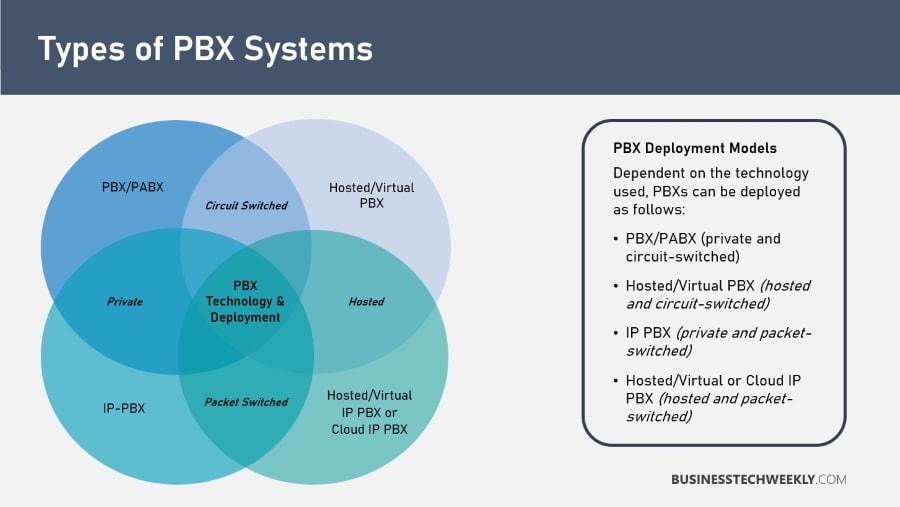
PBX/PABX
PBXs are based on-site, at the office location where the telephony service is required. On-site, or private PBXs, can be owned or leased and are maintained and administered by the business.
PBXs were originally designed based on circuit switching to make an end-to-end physical connection using the public switched telephone network (PSTN). These make use of copper or ISDN lines connected from the public network to the PBX.
As automated PBX solutions became common, they began to be referred to as private automatic branch exchange (PABX). However, all modern PBX solutions are automated, and the terms PBX and PABX are used interchangeably to describe the same system.
Hosted/Virtual PBX
Hosted or Virtual PBX solutions deliver PBX functionality as a service to connect to the public switched telephone network (PSTN). Virtual PBXs are provided by a telephony service provider, using circuit switching equipment located, or hosted at the telephone exchange.
In general, the PBX functionality is provided by way of a lease agreement. Depending on the configurations, a provider may use the same switching equipment to service multiple hosted PBX customers.
For example, Centrex is a type of hosted PBX service offered by telecommunications providers that provided PBX capabilities. While a significant number of businesses have transitioned to IP PBX systems, Centrex is still used predominately in government organizations and schools.
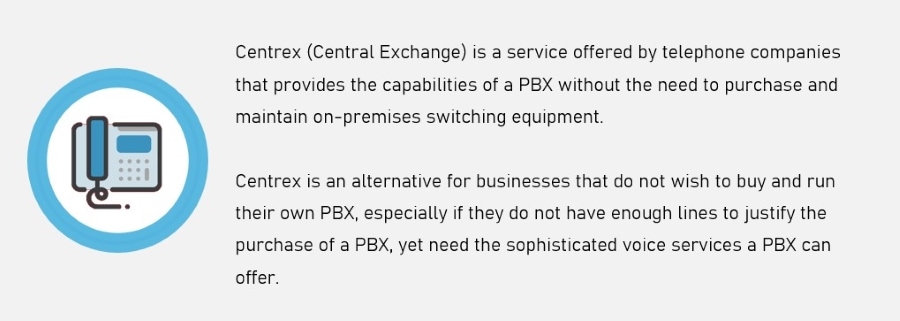
IP-PBX
An IP PBX uses the internet protocol (IP) to transmit and receive voice signals over the internet. The internet protocol allows voice signals to be sent and received using packet switching (rather than circuit switching).
Based on-site, i.e. private, IP PBX connect to the wider PSTN using SIP trunks. SIP is an acronym for Session Initiation Protocol and is a way to establish and terminate data and voice transfers over the internet.
An IP-PBX can either be physical, as a specialist piece of hardware, or virtual, in software form, often referred to as a “Soft PBX”.
Hosted/Virtual IP-PBX
Virtual or hosted IP PBX solutions deliver IP PBX operations via the internet while hosting the IP PBX at a telephony service provider operated data centre.
This approach allows organizations to retain control of their phone system whilst remotely hosting the IP PBX with a third-party hosting provider.
Hosted/Virtual IP PBX is ideal for businesses who may not have the infrastructure or space available but still want to oversee and manage their telecommunications.
Cloud IP-PBX
While similar to hosted IP PBX in terms of deployment, Cloud IP PBX refers to an IP PBX hosted and managed by a third-party service provider. Cloud IP-PBX services are delivered via the internet, typically as a Software-as-a-Service (SaaS) subscription.
Cloud IP-PBX solutions allow a business to host their PBX communications system with a third-party service provider and also have the management, maintenance and upgrades taken care of by the same provider.
In general, telephony providers offer the Cloud PBX service on a subscription model, usually on a per user per month basis.
Comparing PBX technologies and deployments
PBX systems, whether circuit-switched or packet-switched, can be located either within the premises of an organization (private or on-premise) or at the service provider premises (virtual or hosted).
Here we look at each of the options and how they compare with one another.
Circuit Switching Vs Packet Switching
Circuit switching, specifically for voice communication, requires a dedicated channel, or circuit, to be established, creating a dedicated physical path between the caller and recipient, before they can speak to one another.
Once the circuit is established, the entire message is sent, in its entirety, through the dedicated channel.
In contrast, packet switching does not need a dedicated channel to be established. Instead, packet-based networks transmit the message by breaking it down into smaller data packets.
For efficiency, each data packet could take a different route. Since the packet header contains the source and destination address, the packets can be extracted and reassembled to create the original message once the data packets reach the correct destination.
The more traditional public service telephone network (PSTN) uses circuit switching to transmit voice data, while VoIP systems use packet switching.
With telecommunication carriers expecting to move to IP-enabled networks by 2025, it seems packet-switched IP-based systems are the way forward.
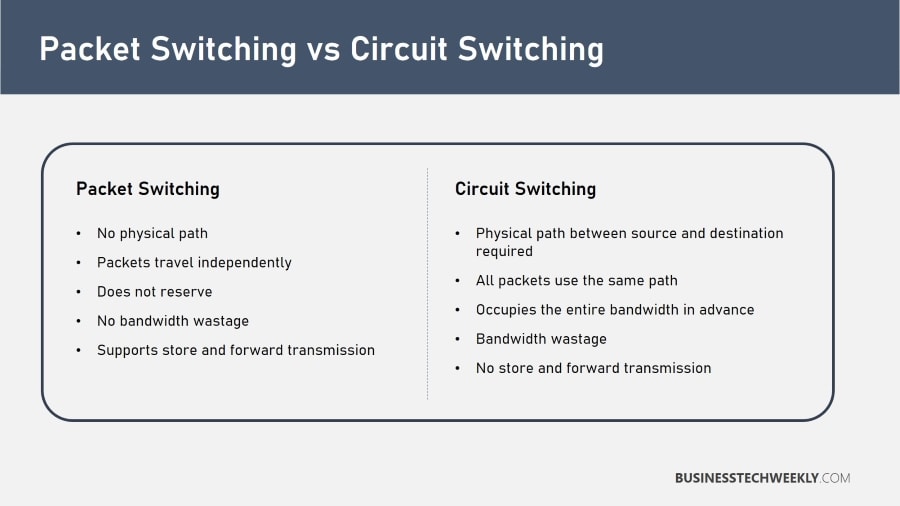
On-Premise Vs Hosted PBX Vs Cloud PBX
When upgrading your business communications, there are many points to consider. A sensible place to start is to consider whether to opt for an on-premise or hosted solution.
This decision will be dependent on a few factors such as your company’s size, existing infrastructure, available budget, resources, and what you need from your PBX.
Before making this decision, it’s sensible to be clear on the benefits each option offers.
On-Premise PBX
On-premise PBXs are suited to larger organizations with the appropriate infrastructure and resources to operate and manage the telephony system. In most cases, such organizations operate in sectors that are regulated and require stringent security and confidentiality.
- Allows the business more control over their phone solution
- Appropriate for organizations that have the infrastructure, resources and network setting required to host their telephony solution
- Decreased reliance on a third-party PBX provider for simple administrative tasks such as adding new users, or extensions
- The business holds the data and settings
- Option to acquire third party support and maintenance if required
Hosted PBX
Hosted PBXs offer the ability to retain some control over your telephony solution while hosting the associated equipment with either the vendor or third-party provider.
- Allows businesses to locate their PBX remotely, with a third-party hosting provider
- Allows business to choose their hosting and SIP trunk provider to tailor a solution that fits the business requirements and budget
- Can offer reduced maintenance, operation and installation costs
Cloud IP PBX
Cloud IP PBX, viewed by some as a subset of a hosted PBX, is the preferred deployment for SMBs. Cloud PBXs are offered as Software-as-a-Service (SaaS) subscription and ideal for organizations with limited resources and infrastructure.
- Organizations do not need to consider infrastructure capacity or requirements, such as bandwidth, or their network environments
- The third-party provider manages the PBX and has the responsibility of upgrades and maintenance
- Businesses do not require dedicated technical personnel to manage the telephony solution
- Staff do not require specialized training on administering the telephony solution – such tasks are taken care of by the IP PBX provider
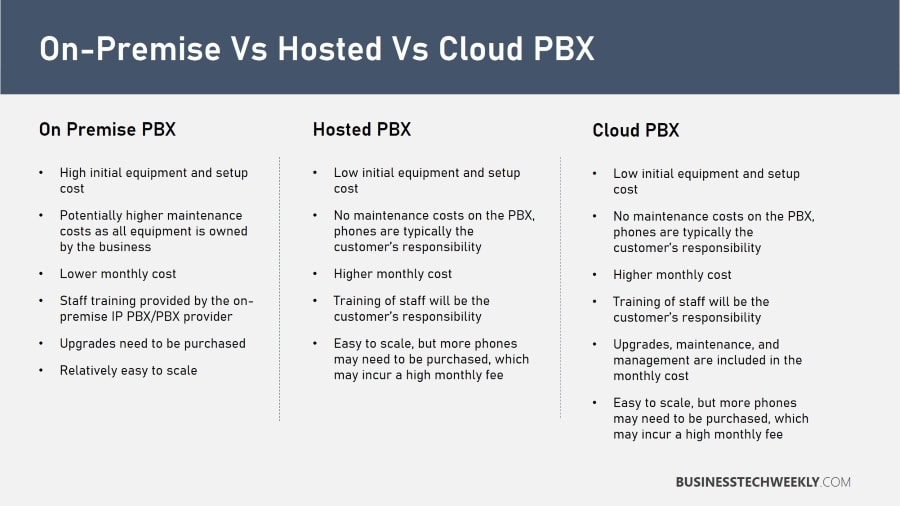
What is the best PBX Solution for my Business?
The trend for PBX solutions has been towards the use of IP. Consequently, if you are seeking to upgrade or replace your existing telephony solution, an IP PBX system, whether on-premise or hosted, should be given serious consideration.
Larger organizations, generally with higher call volume, and therefore call processing requirements, are likely to opt to procure and maintain an on-premise IP PBX solution to adapt to their specific needs.
In contrast, smaller companies looking to limit their capital outlay, while obtaining a certain degree of customization and scalability with their needs, are likely to look at hosted IP PBX solutions.

